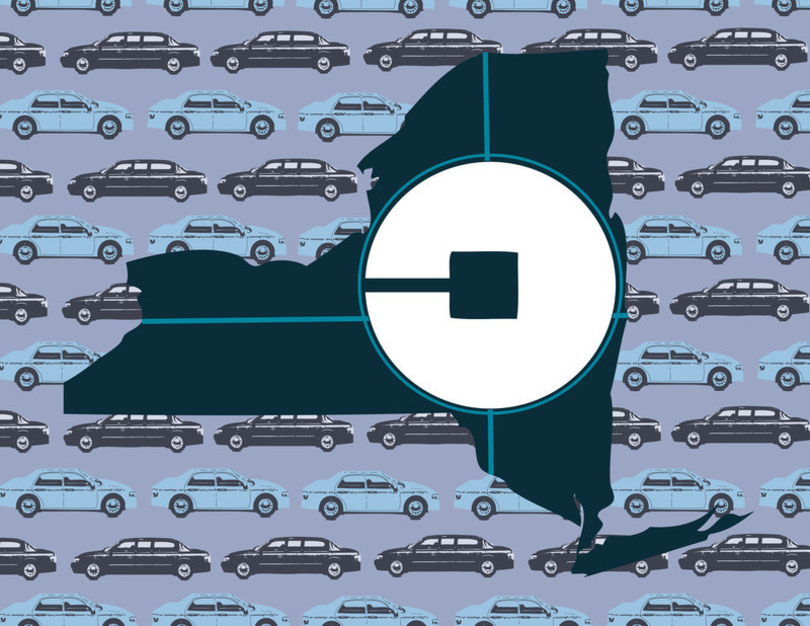Uber, and its recent arrival to Syracuse, explained

Emmy Gnat | Staff Illustrator
After a push from New York state lawmakers, Uber and Lyft started their ride-hailing services before Fourth of July weekend.
UPDATED: July 6, 2017 at 9:43 a.m.
After years of debate, ride-hailing services like Uber and Lyft have been legalized statewide in New York.
The state Senate and Assembly in April reached an agreement to establish a regulatory framework for the apps in upstate New York and suburban counties near New York City.
Services such as Uber and Lyft have found global success, spread across the United States and revolutionized the transportation industry. Ride-hailing services operated for years in NYC before recent budget negotiations prompted lawmakers to resolve longstanding disagreements over insurance and safety requirements. Those disagreements were resolved in 2017, bringing the services to places like Syracuse.
Uber and Lyft both stepped up their lobbying efforts last year, with Uber aggressively campaigning local and state politicians from across New York.
The politics of the issue remain complex. Different groups such as taxi industry associations and labor unions still oppose ride-hailing services moving into upstate areas and cities.

What are ride-hailing services?
Ride-hailing services are similar to taxi services, in that passengers can call for a vehicle to take them to a destination of their choice.
Services such as Uber and Lyft, unlike taxis, operate entirely through a mobile application. To use Uber, for example, passengers must download the Uber app and set their location to request a ride. An Uber driver, which just about anyone can sign up to be, then picks up and transports the passenger.
Uber and Lyft also offer ride-sharing options. For discounted prices, passengers can choose to share their ride with another rider, something that typically isn’t offered with taxis.
What happened in April?
Lawmakers, prompted in part by Gov. Andrew Cuomo, made ride-hailing services a priority at the end of the legislative session. In an interview this spring, Sen. James Seward, R-Milford, said fellow representatives in the Senate and Assembly discussed ride hailing during 2018 fiscal year budget negotiations.
Several compromises were made between Senate and Assembly members.
One key compromise was an “opt-out” measure, which allows every county in New York and cities with 100,000 residents or more, outside of NYC, to ban ride-hailing services within their jurisdictions.
A spokesman for Syracuse Mayor Stephanie Miner in April told The Daily Orange Miner plans to comply with the new regulatory framework, allowing companies like Uber to operate in the city. Onondaga County Executive Joanie Mahoney said the county also plans to comply.
The Senate and Assembly disagreed over how much insurance coverage should be required for ride-hailing service drivers, but came to a resolution.

What has happened since then?
Lawmakers fast-tracked the services’ legalization date. Originally, companies like Uber and Lyft were scheduled to begin operation in New York as early as July 9. Instead, they became legal on June 29 in anticipation of Fourth of July weekend.
Has Uber spent a lot of money lobbying in New York?
Uber had spent more than $1 million between July and December 2016, lobbying both state and local officials, according to the New York State Joint Commission on Public Ethics.
For example, in Syracuse, Uber directly lobbied Alexander Marion, spokesman for Miner’s office. The company also lobbied Chief of Staff Bill Ryan. From January to June 2016, Uber spent $266,164 lobbying in New York, according to the commission.
Lyft, in comparison, only spent $5,545 lobbying from July to December last year. The company spent $3,851 from January to June 2016, according to the commission. Most of that money was spent on officials in suburban counties near NYC.
Data on Uber and Lyft’s lobbying from January to June 2017 is currently not available.

What’s the controversy with ride-hailing services?
Essentially, those who oppose ride-hailing services believe they aren’t required to play by the same rules as taxi companies.
Opponents have argued that if ride-hailing services were to operate in New York state, they should have to supply their drivers with auto insurance and workers’ compensation, a type of insurance that provides workers with wage replacements in the case of work-related injuries.
Uber and Lyft, unlike taxis, do not typically provide their drivers with workers’ compensation since its drivers are considered independent contractors.
“The bill that was passed in New York this spring, though, requires ride-hailing services to provide their drivers with workers compensation.”
Additionally, opponents have also pointed out that ride-hailing services often have lesser background checks than taxis, which they say make the services inherently less safe.
What comes next?
That has yet to be seen. Advocates for the services, and those opposed to the transportation apps, will surely monitor the rollout of Uber and Lyft in upstate carefully.
Graphics by Emma Comtois and Andy Mendes | The Daily Orange




